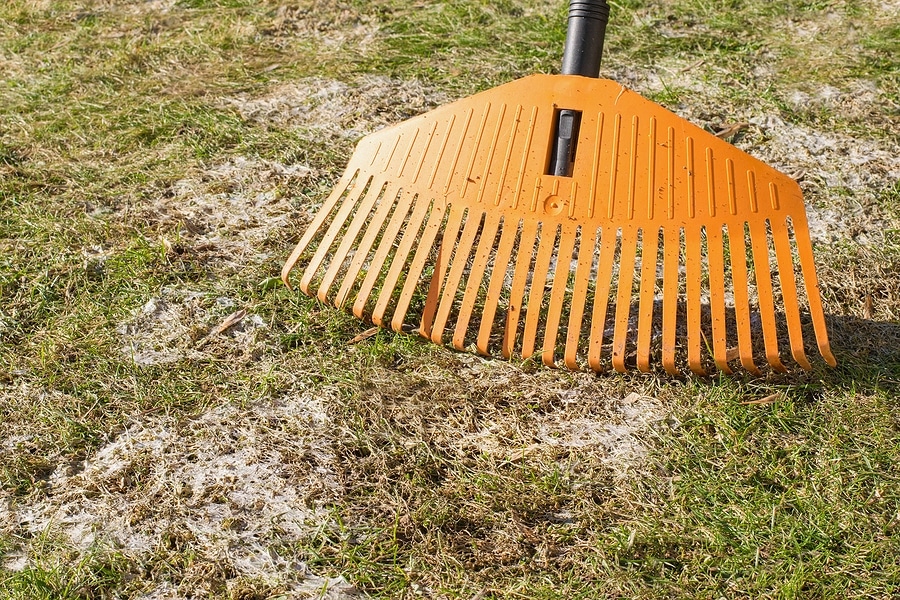As winter fades and spring approaches, many homeowners eagerly anticipate the sight of green grass emerging from beneath the melting snow. However, for some, the joy of spring can be dampened by the unwelcome presence of snow mold on their lawns. Snow mold, a common fungal disease that thrives in cold, wet conditions, can leave unsightly patches of dead or discolored grass in its wake. Continue reading to learn more from the team at Lawn Plus LLC.

What Is Snow Mold?
Snow mold is a fungal disease typically occurring when snow accumulates on lawns for an extended period, creating a moist environment conducive to fungal growth. There are two primary types of snow mold: gray snow mold and pink snow mold. Gray snow mold appears as circular patches of grayish-white, matted grass, while pink snow mold presents as pinkish or reddish patches with a slimy texture. Both types of snow mold can cause significant damage to turf if left untreated.Snow Mold Signs and Symptoms
Identifying snow mold on your lawn is relatively straightforward, especially as the snow begins to melt in early spring. Look for patches of grass that appear matted, discolored, or dead, often surrounded by a halo of lighter-colored grass. You may notice a musty or sour odor emanating from affected areas in severe cases. Additionally, closely inspect the grass blades for signs of fungal growth or web-like mycelium, which may indicate the presence of snow mold.Recovering from Snow Mold
If you discover snow mold on your lawn, don’t panic. With prompt action and proper care, you can restore your lawn to its former glory. Here are some steps to help you manage snow mold effectively:
- Rake and Remove Debris: Begin by gently raking affected areas to remove matted grass, thatch, and debris. This helps improve air circulation and promotes drying, which inhibits fungal growth.
- Aerate the Soil: Aerating the soil helps alleviate compaction and improve drainage, creating an environment less conducive to snow mold development. Use a core aerator to perforate the turf and allow air, water, and nutrients to penetrate the soil.
- Overseed Damaged Areas: Once you’ve addressed the underlying issues, overseeding can help fill in bare patches and promote new grass growth. Choose a high-quality grass seed blend suited to your region and lawn conditions, and follow proper seeding practices for optimal results.
- Fertilize and Water Appropriately: Proper fertilization and watering are essential for promoting healthy grass growth and preventing future outbreaks of snow mold. Apply a balanced fertilizer according to soil test recommendations, and water deeply but infrequently to encourage deep root growth and drought resistance.
- Mow Regularly: Maintain a consistent mowing schedule, keeping grass at the recommended height for your turfgrass species. Avoid cutting grass too short, as this can stress the turf and make it more susceptible to disease.
- Monitor and Prevent: Keep a close eye on your lawn throughout the growing season, monitoring for signs of fungal disease and taking preventive measures as needed. Avoid excessive thatch buildup, improve soil drainage, and minimize prolonged snow cover to reduce the risk of snow mold recurrence.
Preventing Snow Mold
While treating existing snow mold is essential, taking proactive steps to prevent its occurrence in the future is equally important. Here are some preventive measures to help safeguard your lawn against snow mold:
- Proper Fall Lawn Care: Before winter sets in, prepare your lawn for the cold weather by mowing grass to the appropriate height, removing leaves and debris, and addressing underlying issues such as thatch buildup or compaction.
- Reduce Snow Cover: Minimize the duration of snow cover on your lawn by shoveling or blowing snow away from susceptible areas, especially around trees, shrubs, and other landscape features.
- Improve Air Circulation: Prune overhanging branches, thin out dense vegetation, and avoid piling snow in one area to promote better air circulation and reduce moisture accumulation.
- Choose Resistant Grass Varieties: Select grass varieties less susceptible to snow mold, such as fine fescue or perennial ryegrass, and overseed with resistant species to strengthen your lawn’s resilience.
Lawn Plus LLC offers professional lawn care services to Dayton and the surrounding areas. Contact us today at (937) 839-5296 to request your quote.
